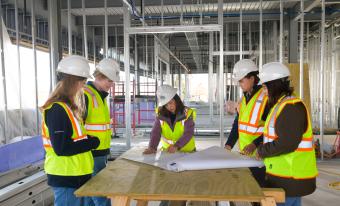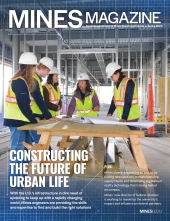Mines civil engineers are constructing future of urban life

Construction Engineering Professor of Practice Karen Gupta, center, and students Mimi Clot De Broissia, Herbert Hafenrichter, Sarah Gifford and Dayanira Gallegos review blueprints inside the Beck Venture Center construction site on the Mines campus. (Photo by Cyrus McCrimmon/Special to Mines Magazine)

By Jen A. Miller, Special to Mines Magazine
Engineers have long played an important role in designing the structures and systems that make our lives go. They enable things like providing clean water, energy, information and more, particularly in increasingly dense urban areas. These systems often require complex and elaborate infrastructure installations but often become outdated or can’t keep up with today’s societal demands.
These problems are now widespread. According to the American Society of Civil Engineers, a water main breaks every two minutes in the U.S., and an estimated 6 billion gallons of treated water are lost every day. Nearly half of the country’s public roadways are in poor or mediocre condition, and the nation has 10,000 miles of levees whose location and exact condition are unknown. Add to this climate-related pressures, like lower snowfall rates that affect drinking water and hydropower, increased demand for electric vehicle chargers at work and at home, hotter and longer forest fires in some pockets of the country and stronger and more frequent storms in others, and our infrastructure is strained beyond its limits.
Mines engineers are working to address our country’s infrastructure problems and set the nation on a path to a more sustainable and resilient future. As state, local and federal governments grapple with how to maintain and upgrade these critical pieces of infrastructure to prepare for a future in a rapidly changing world, Mines engineers are stepping up to the plate.
“We recognize that the way we interact with the resources around us needs to become more intentional, and the way you become more intentional is by creating a plan and executing a plan and following and tracking whether or not that plan is being executed,” said Adam Phipps ’08, executive director of the Department of Transportation and Infrastructure for the City and County of Denver. “We need engineering, and our involvement, to align with the resources available to us.”
Facing physical infrastructure challenges with public and private funding
The Bipartisan Infrastructure Law, enacted in 2021, is historic in how it will help engineers re-envision how America lives in significant ways, said Phipps.
First is its sheer size and scope: $1 trillion to support transportation, climate, energy and environmental projects and the expansion of broadband. “We haven’t seen this substantial of an investment in infrastructure in our lifetimes,” he said.
Second is that, instead of the federal government giving all of that $1 trillion to states to decide what to do, 45 percent of the funding is being given out via grants directly to cities and counties. The investments are hyperlocal and enable local governments to fund projects that will make the most local impact.
“How we as a society most influence change and increase the quality of life is to invest at the lowest level possible,” Phipps said. “We have the ability to respond to the needs of our people and our communities.”
It’s especially needed in Colorado, which received a C- average on the American Society of Civil Engineers 2021 report card. The group found that the state had aggressively adopted renewables, made strides in transit and maintained roads at an above-rate average compared to other states. But Colorado also had not raised gas or diesel taxes in 30 years. Despite an added two cent per-gallon increase slated for July 1, 2023, three decades of resting at the same rate has forced Colorado to do more—for more—with less. In 1991, the last time gas and diesel taxes were previously raised, Colorado had 3.4 million residents. That’s now up to 5.8 million, according to the U.S. Census Bureau.
An influx of federal money, distributed where local governments see best suited, will help address these infrastructure gaps and needs, said Phipps.
Mines engineers are also working in the private sector to meet increased infrastructure demands by redeveloping existing structures and building new ones to ensure that new systems and structures are built and designed to be as sustainable as possible. That’s especially key in the West, where water is and will continue to be a challenge, said Randall Phelps ’96, senior vice president and principal of Kimley-Horn.
“We have finite resources when it comes to runoff from snowmelt, so the availability of water is an everyday conversation here,” he said. That’s because managing water affects the design of just about everything, including roadways, sewer networks, stormwater management systems, water loops, parking structures, pavement grading in parking lots and landscape architecture.
The company also works on what Mikaela Moore ’18, project engineer at Kimley-Horn, called “dry utilities”—things like electrical capacity, EV chargers at businesses and homes and meeting demand for at-home internet that has increased since the COVID-19 pandemic. “It’s a big challenge across most of our projects,” she said.
When building a new development, even if it’s outside of the urban core, engineers often still deal with outdated infrastructure, like “very old sewer or water lines that we’re trying to maintain or tap into,” said Willie Konishi ’19, a civil analyst at Kimley-Horn. “It’s a challenge to work around those existing gaps in our infrastructure and then a lot of times having to update that infrastructure.”
Engineers in this space are thinking about how to improve infrastructure constantly, said Moore. “How do you deal with stormwater? How do we make these EV chargers work? How do we make things better for pedestrians? What about bike paths? We’re engineering solutions every single day,” she said.
The future of urban landscapes
When thinking about how to make cities greener, more resilient, more accessible and easier to navigate, engineers know they are “restricted by how much the urban landscape is already built out,” said John Courtney ’07, program director for the City and County of Denver. “Whether it’s transportation or new building construction, it doesn’t really matter in an area like Denver because there’s not a lot of open land to go build a new road or a new recreation center or police station.”
One of his key projects right now is at the Colorado Convention Center: an expansion that will add 80,000 square feet of meeting and ballroom space, 35,000 square feet of pre-function space and a 20,000-square-foot outdoor terrace. Instead of trying to expand outward into space Denver doesn’t have to spare, it’s going up: the addition is being built on top of the existing convention center.
Planners and engineers are “repurposing existing infrastructure and either retrofitting it or doing larger demolition projects to make way for new construction projects,” he said. Engineers are creative in that they figure out how to make older buildings more energy efficient while also handling unforeseen challenges like existing infrastructure that weren’t on any blueprints.
Cities are going to be affected by what’s beyond their limits, he added, as is the infrastructure that supports them. “As the climate changes, that means that infrastructure we relied on, like dams and hydropower, maybe we can’t rely on them in the same way anymore,” he said. As concerning as that is, he added that engineers are being prompted to “establish new means of infrastructure” to figure out how to manage those resources as they change and find new solutions.
Preparing the next generation of engineers
To meet the needs of both public entities and private businesses to rebuild and improve the country’s existing infrastructure, Mines is launching a new Bachelor of Science in Construction Engineering in Fall 2023. It grew organically from both students showing an interest in the field and alumni working in the construction industry making a compelling case that such a degree is needed, said Junko Munakata Marr, professor and head of the Civil and Environmental Engineering Department at Mines.
“A lot of our alumni from civil engineering are working construction and suggested that Mines add this degree,” she said, adding that these alumni have also stepped up to help the school figure out the best kind of degree to offer and the curriculum.
Not only will students working toward this degree get the foundation of how to be a construction engineer and practice tackling real problems, but they will also be challenged to push the industry to think more sustainably than it is right now.
“There are not enough analytical people who are out there asking how we can do this in a better way,” said Karen Gupta, professor of practice for the Construction Engineering program. “Everybody sees sustainability as being different and being expensive. It doesn’t have to be expensive, and it doesn’t have to be different. That’s part of the core that Mines teaches, and that’s what we’re going to teach, too.”
Both Moore and Konishi guest lecture at Mines and see the school as poised to train construction engineers to meet these infrastructure challenges.
“We focus most of our lectures and presentations on the broader picture of what does development work do and what does consulting work do and what does the word infrastructure mean?” said Moore.
“And students ask the best questions,” Konishi added. “We go into this class every semester and always have students asking tough questions, like ‘how do you tie green infrastructure into your projects,’ and ‘how do you deal with municipalities that aren’t willing to accept different things?’”
Munakata Marr sees the construction degree working for Mines students specifically because it will do what Konishi says: “build on the strength of our civil engineering program” she said, and take the same kind of real-world, problem-solving approach to teaching the specifics of working in the construction world. That way, another generation of Mines students will be leading the way into a newer, greener, infrastructure-resilient world, wherever that kind of expertise is needed.
To learn more about the new Bachelor of Science in Construction Engineering, contact Junko Munakata Marr at jmmarr@mines.edu.




